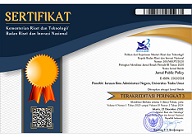The Analysis of Vertical Mismatch and Manufacturing Labor Wage by Using Cramer's V Method
Abstract
As the leading sector of the national economy through its contribution, the manufacturing industry sector in Indonesia was precisely filled with the dominance of vertical mismatch or mismatch between education levels and types of work based on the 2015 National Labor Force Survey (Sakernas). The negative effects of vertical mismatch have an impact on the low wages earned by labor because investment at the education level is not maximally used when working. This paper aims to study the tendency of vertical mismatch to labor wages in the manufacturing industry sector by training, education level, region, & generation using descriptive analysis methods (crosstabulation & graphics) and Cramer's V to see the correlation with August 2015 Sakernas data. The results of research with the total sample of 1,259 workers shows that vertical mismatch is significantly related to labor wage with the tendency of workers who are overqualified to face low wages. In addition, overqualified workers occur in all regions of Indonesia with the characteristics of younger generations and Diploma IV / S1 graduates. The conclusion of this paper is that industrial labors in Indonesia are still classified as overqualified and experience low wages. The efforts that need to be done are improving the skills of workers through training so as to have a positive effect on mismatch workers to obtain higher wages.
Keywords
Full Text:
PDFReferences
Adioetomo, Sri Moertiningsih. (2019). “Aplikasi Demografi untuk Bisnis”. Paparan Kuliah Bisnis Demografi. 10 September 2019.
Alisjahbana, Armida S, dkk. (2018). “Mismatch Pendidikan & Pekerjaan Bagi Kaum Muda di Indonesia”. Paparan Seminar Nasional Kesiapan SDM Indonesia di Era Disrupsi dan Globalisasi, Universitas Padjadjaran.
Allen, Emma R. (2016). Analysis of Trends and Challenges in Indonesian Labor Market. Manila: Asian Development Bank.
Amador, Nicolas dan Villa. (2006). “Education and Competence Mismatches: Job Satisfaction Consequences for Workers”. XVI Jornadas ASEPUMA-IV Encuentro International vol.6. No1:105.
Badan Pusat Statistik. (2018). Keadaan Angkatan Kerja di Indonesia Agustus 2018. Jakarta: Badan Pusat Statistik.
_____. (2018). Pendapatan Nasional Indonesia 2014-2018. Jakarta: Badan Pusat Statistik.
Becker, G.S. (1975). Human Capital 3rd editions. Chicago: The University of Chicago Press.
Bender et al (2006). “Educational Mismatch among Ph.D.s: Determinants and Consequences”. Working paper No 12693 National Bureau of Economic Research.
Bureau of Public Cooperation & Communication. (2019). Press Released in https://ristekdikti.go.id/kabar/kemenristekdikti-dan-kementerian-bumn-jalin-kerja-sama-program-magang-mahasiswa-bersertifikat-9-000-mahasiswa-akan-diterima-magang-di-113-bumn/. Accesed on January 22nd 2020.
Iryanti, Rahma. (2017). Education & Skill Mismatch di Indonesia: Kondisi Saat ini dan Kebijakan Pemerintah. Jakarta: Bappenas.
Korpri and Tahlin. (2007). “Educational Mismatch, Wages, and Wage Growth: Overeducation in Sweden, 1974-2000”. Working paper 10/2007. Stockholm University.
Payaman, J. (2001). Pengantar Ekonomi Sumber Daya Manusia. Jakarta: Lembaga Penerbit Fakultas Ekonomi Universitas Indonesia.
Robst, John. (2006). “Education and Job Match: The Realtedness of College Major and Work”. Jurnal Elsevier tanggal 7 Agustus 2006.
Samudra, Rachmat. (2018). “Job Mismatch and Age-Earning Profile in Indonesia”. Paparan Seminar Lembaga Demografi, Fakultas Ekonomi dan Bisnis, Universitas Indonesia.
Schultz, T. Paul. (1961). Education Investment and Returns in Handbook of Development Economics. Vol I. Chapter 13, pp 543-621.
Sukirno, Sadono. (2010). Mikro Ekonomi Teori Pengantar. Jakarta: PT Raja Grafindo Persada.
Soesilowati, Endang S. (2009). “Link and Match Dunia Pendidikan dan Industri dalam Meningkatkan Daya Saing Tenaga Kerja dan Industri”. Jakarta: LIPI.
Wiko, Saputra, dkk. (2011). Fenomena Overeducation dan Underwducation dalam Pasar Kerja Wanita. Jurnal Ekonomi Pembangunan Vol. 12, No. 2, Desember 2011, Hal. 212-220. Pascasarjana, Universitas Bung Hatta, Padang.
Yamin, Sofyan dan Heri Kurniawan. (2009). SPSS Complete Teknik Analisis Statistik Terlengkap dengan Software SPSS. Jakarta: Salemba Infotek.
DOI: https://doi.org/10.35308/jpp.v6i1.1564
Refbacks
- There are currently no refbacks.
Copyright (c) 2020 Jurnal Public Policy
p-ISSN: 2477-5738 I e-ISSN: 2502-0528 I DOI: 10.35308
Jl. Alue Peunyareng, Ujong Tanoh Darat, Meureubo, Kabupaten Aceh Barat, Aceh 23681, Indonesia
(0655) 7110535 l +621260313742 l +6285277110911
 is licensed under a Creative Commons Attribution-ShareAlike 4.0 International License
is licensed under a Creative Commons Attribution-ShareAlike 4.0 International License


